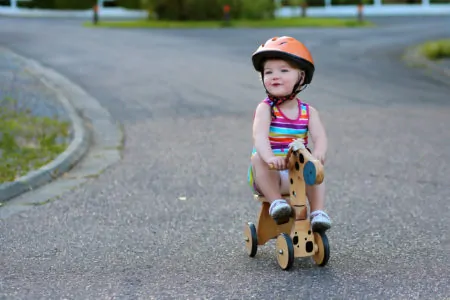It is a scary thought, but accidents happen. In the U.S. alone, nearly 1,000 children visit the emergency room every hour due to unintentional injuries (1). Unfortunately, almost every child will experience a bump, scrape, or fall at some point in their life.
As a parent, understanding the risks is half the battle. We compiled 25 essential child injury statistics to help you spot the hazards before they happen. From playground tumbles to traffic safety, this guide breaks down the facts and offers actionable tips to keep your little ones safe.
Key Takeaways
- Falls are the top culprit: They are the most common cause of nonfatal injuries, with 8,000 kids treated daily in U.S. emergency rooms.
- Home safety matters: Over 3.5 million children visit the ER annually for injuries that happen right inside the house.
- Car seats work: Proper use of car seats reduces the risk of injury in a crash by up to 82 percent.
- Supervision is key: The risk of injury drops significantly in households with higher adult-to-child ratios.
25 Child Injury Statistics You Need to Know
We gathered the most impactful data on childhood safety. This covers everything from the most frequent accidents to specific risks in the home and on the road.
Most Common Injuries in Children
Kids are active and curious, which often leads to mishaps. Here are the seven most common types of injuries parents encounter.
- Falls: Gravity is a tough teacher. A pediatric study confirms that falls are the number one cause of injury, sending 8,000 kids to the ER every day (2). While often minor, these incidents can result in fractures or head trauma.
- Accidental impacts: This category covers walking into walls, getting hit by falling objects, or roughhousing. These “struck-by” injuries are incredibly common (3). Consequences range from bruises and bloody noses to concussions.
- Car crashes: Motor vehicle accidents remain a leading cause of accidental death and serious injury in the United States (4). Proper restraints are vital to prevent head, neck, and spinal damage.
- Suffocation: For children under four, suffocation is a primary cause of injury and mortality (5). Common hazards include choking on food, small toys, or unsafe sleeping environments.
- Poisoning: Curious toddlers often ingest harmful substances found around the house. This includes cleaning products, medications, or even houseplants. Reactions can range from vomiting to loss of consciousness.
- Drowning: Water is a major hazard. A child can drown in as little as one inch of water (6). Nonfatal drowning incidents are also serious, potentially causing long-term brain damage or organ failure due to oxygen deprivation (7).
- Foreign bodies: This refers to kids sticking things where they don’t belong, like a bead in the nose or a splinter in the foot. It is a frequent result of unstructured play and exploration.
Important Information
Other frequent injuries to watch out for include burns, sports-related trauma, bicycle accidents, and minor cuts or scrapes.
Risk Factors Every Parent Should Know
Most children will get hurt eventually, especially during the wobbly toddler years. However, certain factors can increase the likelihood of an accident.
- Adult-to-child ratio: Supervision makes a difference. The risk of injury decreases when there are more adults present to watch the children (8). This is why low staff-to-child ratios in daycare centers are a critical safety standard.
- Economic factors: Statistics show that injuries and fatalities are higher in lower-income communities (9). Limited access to safe play spaces and older housing infrastructure often contribute to this risk.
- Environmental hazards: Your surroundings play a huge role. Children living near high-traffic areas, in crowded homes, or without access to fenced parks face a statistically higher risk of injury.
- Parental supervision: Eyes on the prize, or the kid. A study highlighted that distracted supervision directly impacts injury risk, particularly for children aged four to six (10). Active watching is crucial near water and playgrounds.
- Demographics: Injury rates vary by age and gender. Generally, boys are injured more often than girls. The highest risk groups include babies under one year old and adolescents between 15 and 19 (11).
- Driver behavior: Unsafe driving behaviors, such as speeding or failing to use car seats, are massive risk factors. Motor vehicle crashes continue to cause more fatalities than any other type of accidental injury.
Home and Playground Safety Stats
You might think the living room or the local park are safe havens, but the data says otherwise. Here is what you need to know about injuries in play areas.
- Equipment failure and falls: On playgrounds, 81 percent of injuries involve falls or equipment failure (12). The biggest offenders are usually swings, slides, and climbing bars (monkey bars).
- ER visits are common: More than 200,000 children visit emergency rooms annually for playground-related injuries (13). While most occur at schools or parks, a significant chunk happens on home playsets.
- Types of trauma: When kids get hurt on the playground, fractures are the most common result (36 percent). This is followed by bruises (20 percent), cuts (17 percent), and sprains (12 percent) (14).
- Home injury numbers: Your house is a hotspot for accidents. Roughly 3.5 million children visit the ER every year due to injuries sustained at home (15).
- Storage mistakes: About 30 percent of parents with toddlers store medicines and cleaning supplies on low shelves or in unlocked cabinets, increasing poisoning risks.
- Top home hazards: Falls are the leading cause of nonfatal home injuries, accounting for 1.9 million ER visits annually. Other top causes include bumping into objects (1.08 million), cuts (270,000), burns (93,000), and poisoning (47,000).
Traffic and Car Safety Statistics
Traffic incidents are among the most dangerous threats to child safety. These six facts highlight why road rules are so important.
- Bicycle accidents: In 2020, nearly 137,000 children visited the ER for bike-related injuries (16). Kids between the ages of five and 14 are at the highest risk.
- Pedestrian risks: The U.S. sees an average of 67,124 child pedestrian injuries per year (17). Danger peaks between 3:00 PM and 7:00 PM, when visibility drops and traffic volume increases.
- Teens on foot: Adolescents aged 15 to 19 are the most likely age group to be injured as pedestrians, likely due to distraction by phones or walking alone more frequently.
- Daily car crash injuries: In 2021, an estimated 445 children were injured in traffic crashes every single day (18). This marked a 17 percent increase from the previous year.
- Teen drivers: Drivers aged 16 and 17 have the highest crash rates of any age group (19). Their lack of experience puts them, and their passengers, at significant risk.
- Booster seats work: Legislation matters. States that increased the booster seat age saw a 17 percent decrease in fatal or incapacitating injuries (20). Overall, car seats can reduce injury risk by over 80 percent.
Actionable Tips for Preventing Injuries
Even the most attentive parents can’t predict every stumble. However, many injuries are entirely preventable with a few proactive steps.
Start by teaching your kids the basics of road safety. Ensure they always wear bike helmets and protective gear. Explain the rules of the road, including how to use crosswalks and why they must wait for traffic lights.
Inside the car, education is your best defense. Learn how to use car seats correctly. It is common to make small installation errors, but these can reduce effectiveness during a crash. If you are unsure, visit a local fire station or car seat specialist for a quick inspection.
Here are more specific ways to accident-proof your life:
- Water safety: Never leave a child alone in the bath, not even for a minute. Supervise closely at pools and enroll your kids in swim lessons early; many programs accept infants as young as six months.
- Fall prevention: Clear tripping hazards like loose rugs or toys. Install safety gates at the top and bottom of stairs and avoid using baby walkers on wheels.
- Burn protection: Keep kids away from the stove and radiators. Store matches out of reach and lower your water heater temperature to below 120 degrees Fahrenheit to prevent scalding.
- Poison control: Lock cleaning supplies and medications in high cabinets. Never refer to medicine as “candy” and keep the Poison Control number (1-800-222-1222) saved in your phone.
- Kitchen safety: Cook on the back burners when possible. Avoid holding a baby while drinking hot coffee or cooking.
- Choking hazards: Cut food into safe, small pieces (especially grapes and hot dogs). Keep small objects like coins, marbles, and button batteries away from toddlers.
- Safe sleep: Prevent SIDS by placing babies on their backs to sleep on a firm mattress. Avoid heavy blankets, bumpers, and stuffed animals in the crib. Use a sleep sack instead of loose bedding.
- First aid: Take a CPR and first aid certification course. Knowing what to do in those first few minutes of an emergency can save a life.
- Anchor furniture: Secure heavy dressers, TVs, and bookshelves to the wall. This prevents them from tipping over if a child tries to climb them.








